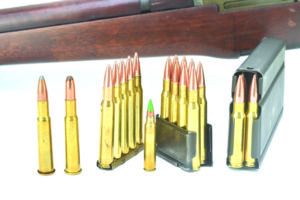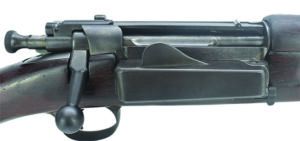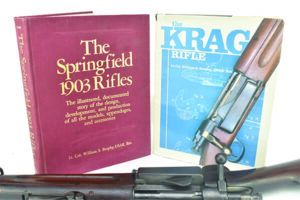Do you ever look at an old firearm and wonder what stories it could tell you? We do. So, we are going to bring you four rifles, all produced by Springfield Armory over a period of some 85 years, and tell you a few of their tales. Perhaps their back stories will light a spark of interest in you to look at one of these items for yourself.
First up is an 1898 Krag-Jorgensen that has been modified by various owners.
Next is a Springfield ‘03 with a receiver that dates to 1931 and the barrel to 1928. That one was rebuilt by the government around the end of World War II and still looks great.
This is followed by an M1 Garand that serial-number records show was built in 1943. This one was a Director of Civilian Marksmanship sale, and we see the barrel was replaced at some point.
The last is a National Match M1A we believe was produced in the mid-1980s. This M1A is a semi-auto version of the famous M-14 and was used by a long-deceased friend in NRA High Power matches over a number of years.
Springfield Armory (located in the city of Springfield in western Massachusetts) was an arsenal for the U.S. federal government from 1777 until its closing in 1968. Obviously known for their firearms, Springfield also helped introduce concepts such as interchangeable parts and the assembly-line method of mass production to the industrial world. Our sources tell us that these innovations allowed Springfield Armory, thus the Union, to outproduce Confederate firearms production by a factor of 32 to 1. Robert McNamara announced the closing of Springfield Armory in 1968, and it lay dormant until the Reese family bought the rights in 1974. Their initial efforts stayed true to the history of the brand with the production of M1 Garands, 1911-style pistols and a semi-auto version of the M-14. As of 2021, Springfield Armory is one of the larger producers and firearms importers in the U.S., having added AR-15 and AR-10 style rifles to the product mix, along with the excellent XD and XDM lines and more. The year of 2020 saw the release of the Waypoint, a lightweight hunting/precision bolt-action rifle.

To see what these rifles could do, we fired them at American Shooting Centers in west Houston. We used a Caldwell TackDriver front bag and a large rear bag from T.A.B. Gear. Groups were shot with iron sights at targets 100 yards away. Keeping the age of the rifles in mind, we babied them with our ammo selections. For the Krag, we used 30-40 Krag Winchester 180-grain Power-Points. Ammo for this chambering is normally produced in limited quantities, so if you find some and you have a Krag, jump on it. Based on published advisories and a great deal of experimenting (see the June 2021 edition of Gun Tests for our report on Garands and gas plugs), we used reloads for the ’03 as well as the Garand. These consisted of 155-grain Sierra Match King bullets on top of Remington brass, CCI large rifle primers, and IMR 4895 powder. According to the manuals, our pressures should have been in the low 50,0000-psi range. The M1A was fed a well-proven 308 Winchester load consisting of 168-grain Sierra Match King bullets on top of Varget powder and Federal Gold Medal Match large rifle primers. Velocities were measured via Doppler radar as provided by LabRadar. Approximate values of the rifles were determined by researching internet auction sites such as Gunbroker.com to see what buyers were bidding on comparable items.
Here’s what to know about these rifles before you commit your hard-earned money to purchasing one.
Gun Tests Grade: C+
~$500
The 1880s saw smokeless gunpowder replace black powder that had been in use for centuries. The French were first to adopt smokeless with their 1886 Lebel rifle. Mauser was hard on their heels working on German rifles, the Brits brought the Lee-Metford into service in 1888, while the U.S. still fielded the single-shot 1873 Springfields. Chambered in 45-70, the Model 1873s and later variants shot bullets ranging from 405 grains to more than 500 grains at a very slow speed. They projected decent energy, but the trajectory was a rainbow. Trials for a replacement commenced and the 30-caliber Krag-Jorgensen rifle was adopted in 1892. Placed into production in 1894, the Krag was manufactured in both infantry (rifle) and calvary (carbine) versions. There were eventually three rifle variants — the Model 1892, the Model 1896, and the Model 1898. There were also three carbine versions in the Models 1896, 1898, and 1899. Complete and original rifles are pricey. Complete and original carbines are an order of magnitude past that.
| Action Type | Bolt |
| Overall Length | 41.25 in. |
| Barrel Length/Twist | 22.0 in., 1:10 |
| Overall Height w/o Scope Mount | 7.1 in. |
| Weight Unloaded | 7.9 lbs. |
| Weight Loaded | 8.3 lbs. |
| Sight Radius | 18.5 in. |
| Action Finish | Parkerized |
| Barrel Finish | Parkerized |
| Magazine Capacity | 5 |
| Magazine Type | Side loading, internal |
| Stock | Walnut |
| Drop at Comb | 1.25 in. |
| Drop at Heel | 1.8 in. |
| Bedding | NA |
| Buttplate | Steel |
| Length of Pull | 13.25 in. |
| Receiver Scope-Base Pattern | NA |
| Trigger Pull Weight | 5.0 in. |
| Safety | 3 position on bolt knob |
| Made In | USA |

Since so few carbines were produced and the remaining pieces are so expensive, many rifles have been cut down to make faux carbines and need to be examined carefully. Our sample has definitely been rebuilt. The receiver is a Model 1898, the rear sight is a different model, and the upper handguard is another model still. The front sight is of a type that was never officially installed on a Krag. And you thought “frankenguns” didn’t really exist until the advent of the modern MSR.
Krag rifles had a 30-inch barrel with a wooden stock that went almost all the way to the muzzle. Carbines had a much shorter 22-inch barrel along with what we would consider to be a more traditional-length forend. Our sample has the 22-inch barrel along with the forend for the carbine, and there the likeness ends. Properly configured Krags had a small blade front sight. Ours has the larger front blade that would be perfect if the rifle was an ‘03 Springfield. According to pictures from Lt. Col. Brophy’s The Krag Rifle, we have a 1902-model rear sight on a receiver that was made in 1899 or 1900 that should have a 1901 sight. Confused enough, now? We knew that we were getting a parts gun, but the buyer should beware before spending big bucks on a fairly rare carbine.

After all of that, we get to the receiver for a proper Krag-Jorgensen rifle as produced by Springfield Armory. Ammunition rotates clockwise through the magazine from a box that opens on the right side. Put the thumb inside the large lever and push out, then load the cartridges into the magazine one at a time. This method of loading the rifle was greatly superior to a single-shot Trapdoor but was found to be severely lacking when compared to stripper clips used by the Spaniards and Cubans using Mauser rifles against us. The early 30-40 Krag cartridges consisted of a 220-grain bullet at about 2000 fps. Once again, the rifle came in second place to the Spanish Mausers, which launched a 173-grain bullet at approximately 2300 fps, producing a much-flatter trajectory. Attempts were made after the Spanish-American War to increase muzzle velocity to near 2200 fps, at which point the single locking lug on the bolt (versus the dual-opposed locking lugs on the Mausers) started to crack. It is not a good thing when there is a single lug preventing the bolt from traveling rearward straight into your eye.
That single-lug bolt and the rotary magazine also helped produce one of the smoothest actions ever. We have heard it described as buttery smooth, and we have to agree. The bolt cocks on opening and then just glides fore and aft in its travel. The slim receiver has a balance point right on the front of the magazine, and the rifle carries easily in the hand. To do a simple field strip, open the bolt, pulling it all the way to the rear. Holding the bolt in your right hand, use your left hand to lift up the extractor, which is located right above the locking lug. After you have lifted up the extractor one eighth to one quarter inch, rotate the bolt slightly to the left, pull to the rear, and the bolt will slide out. The stock has finger grooves on the forend, a slim wrist, and it ends in a steel buttplate.

This Krag is about 120 years old. The receiver is in excellent condition, but the bore leaves a lot to be desired. Even to folks accustomed to smooth bolts from the likes of Tikka and Masterpiece Arms, the bolt on the Krag was a delight to operate. The two-stage trigger required about a quarter inch of movement and felt like a military trigger. Sights are much more suited to 18-year-old eyes, and your shoulder will feel that steel buttplate. Groups were fair at best, averaging 3.37 inches, but then the 220-grain reload we tried for the heck of it shot a 1.04-inch group with open sights. The rifle is obviously designed to feed full-metal-jacket ammo. Both of the soft-point loads we tried to shoot wanted to catch going into the chamber, but chamber they did.
The Bottom Line
Which rifle would we start a collection with today?
- A sure bet, with great accuracy and gorgeous lines, would be the M1A. They are readily available, both new and used.
- The Garands are becoming more difficult to find, and their prices reflect that. Keep in mind that you are far more likely to find a great shooter than a true collector’s item. Still, good samples are available with a bit of looking and research. They are a fascinating piece of history from the Greatest Generation and are a must for the collector of American historical pieces.
- The 1903s, especially the versions before the A3 models, are our sentimental favorites, but their prices go up and selection lessens every year.
- As shooters, we probably enjoyed shooting the Krag-Jorgensen most of all. Be aware that unscrupulous souls have counterfeited many of the carbines, so do your homework carefully before adding a Krag to the collection. But if you find a good one, you’ll be transported back more than a hundred years every time you pull the trigger.
Range Data
| Rifle Load | Krag-Jorgensen 30-40 Krag Winchester Factory 180 Grain | 1903 Springfield 30-06 Springfield SMK Reload 155 Grain | M1 Garand 30-06 Springfield SMK Reload 155 Grain | M1A 308 Winchester SMK Reload 168 Grain |
|---|---|---|---|---|
| Average Velocity | 2253 fps | 2735 fps | 2818 fps | 2616 fps |
| Standard Deviation | 14.3 fps | 14.2 fps | 11.0 fps | 16.8 fps |
| Muzzle Energy | 2030 ft.-lbs. | 2572 ft.-lbs. | 2645 ft.-lbs. | 2357 ft.-lbs. |
| Best Group | 2.68 in. | 2.42 in. | 2.57 in. | 1.51 in. |
| Average Group | 3.37 in. | 3.04 in. | 3.36 in. | 1.72 in. |
Testing was done at American Shooting Centers on the west side of Houston. All shots were fired from a well-sandbagged position using a Caldwell TackDriver rear bag and a T.A.B. Gear large/heavy rear bag. Muzzle velocities were measured via LabRadar ($559).



























